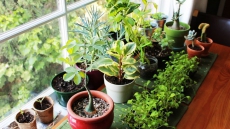A path is a feature too often overlooked in a garden or landscape. Maybe it lacks functionality, or beauty, or it’s needed — but just not there.
A well-designed path can do more than keep your feet dry. It can tell you where to walk, and also guide your eyes and imagination. What’s at the end of the path?
WHERE TO?
When planning a path, consider both its esthetic and functional purposes. Wide paths and paths with jogs or curves are for slow strolling — just what’s needed to encourage a prolonged look at a choice planting. A straight shot is more suited from the back door to the vegetable garden, or any other route where footsteps are hurried.
How many people will walk together on a path? Two people — even two intimate people — need a path 4 to 5 feet wide. In any case, a path should be no less than 18 inches wide.
An orderly design of materials in a path can contribute to the formality and order of a garden: square or rectangular pavers butted together, for instance. Random-shaped pavers create a more organic look for an informal garden.
WHAT’S UNDERFOOT?
One of the easiest and least expensive paths to create and maintain is mowed grass. Arborists’ wood chips are another option. Unconventional materials or combinations of materials can look attractive in their own right. Rounds of black locust, a naturally rot-resistant wood, sunk into pebbles, for instance.
Bricks or stones make paths that not only appear durable; if properly constructed, they are more durable. For brick paths, use nonporous bricks (SW type), which do not absorb water and flake apart during winter freezes. For stone paths, use “flagstone,” which is made by splitting any type of horizontally layered rock into flat slabs, or “flags.” Bluestone and slate are among such rocks, but even concrete could be used if dyed the yellow, buff, tawny red, or gray colour of natural flagstones, and cast into slabs.
A DURABLE PATH
To make a path of brick, stone, slabs, or any unconventional solid material or combination of materials durable, give the solid material firm footing on a well-drained base.
First, mark the path's proposed outline by sprinkling two lines of pulverized limestone on the ground. For a straight path, guide yourself with strings and stakes. Achieve smooth bends on a curved path using two garden hoses as a guide, measuring across at intervals to keep the path’s width constant (if that’s what’s wanted).
Next, remove a 4-inch depth of soil where the path will be. The excavated soil is no longer needed, so pile it directly into a wheelbarrow to be carted away to add to the compost pile or potting mixes, or for use as fill.
Into the excavated area, shovel porous drainage material such as sand or rock dust, tamping it well and smoothing it as you proceed. This material provides a solid base beneath the paving, and prevents water from collecting there, freezing, and heaving up the pavers. Add enough material so that when stones or bricks are in place, their topsides are a little above ground level.
Slope the top of the path to one side if the path is narrow, or crown the centre if the path is wide.
Settle each stone or brick in place tight against each other or, if you’d like plants to grow up in between, leave some space from its neighbours. Creeping thyme or chamomile make attractive and fragrant paving plants.
Once paving is in place, shovel additional stone dust or sand on top of the path, then sweep the material with a broom to fill the cracks. Further settle the material into the gaps with a fine spray from a hose. Repeat the shovelling , sweeping and watering a few days later, after everything has settled.
Time and moisture will imbue the path with a soft patina. For all this mellowing in appearance, the stones, bricks or slabs will give firm footing for decades to come.






